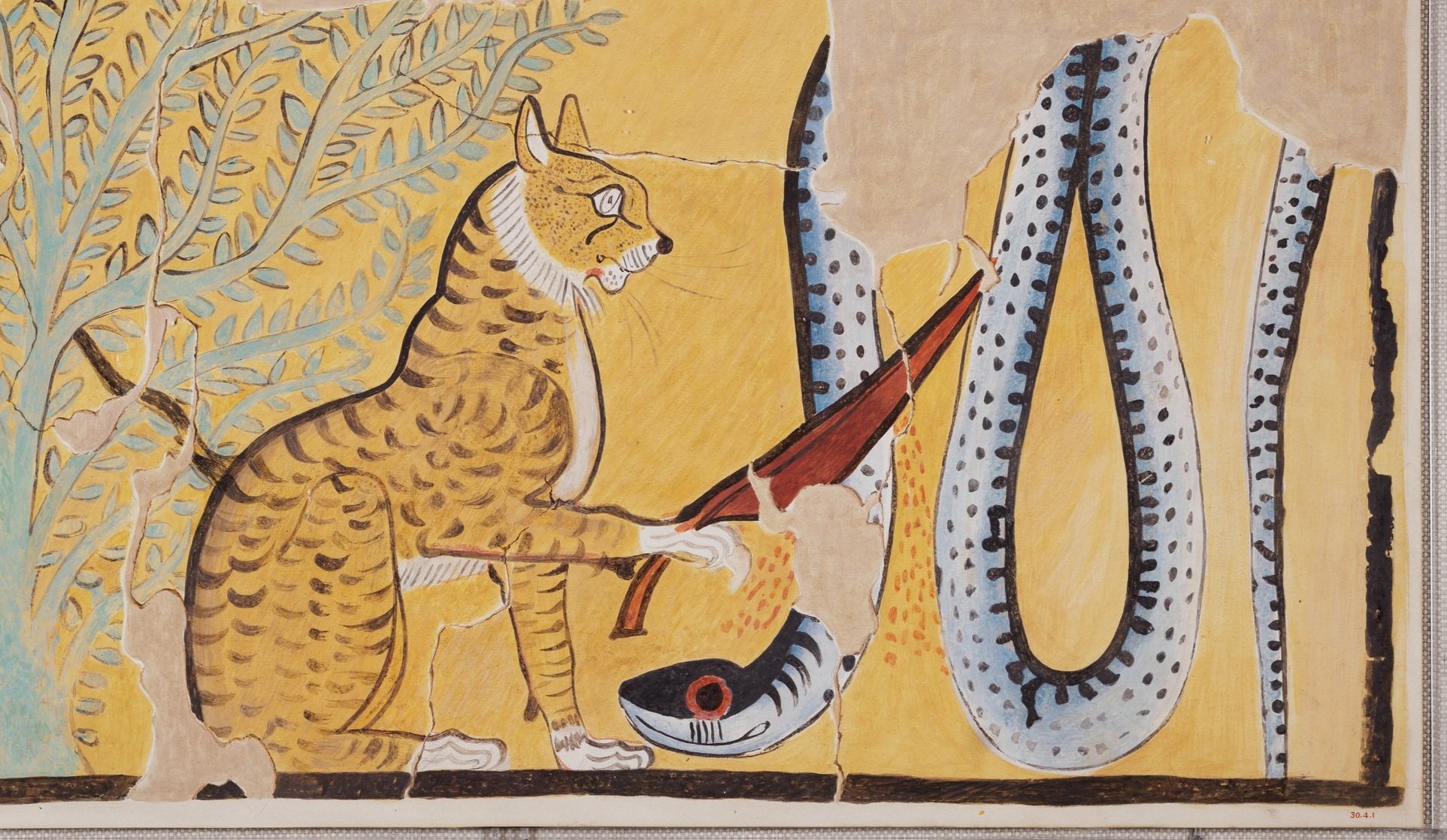Praise to the Great Cat
The combination of an animal head with a human body is a distinctive feature of images of ancient Egyptian deities. Fully human or fully animal representations also appear. Amun, whose most common epithet in the New Kingdom is “king of the gods,” is most often shown in anthropomorphic form, although in Nubian temples he can have a ram head. The goddess Taweret, a protector of women and children, appears almost exclusively as a pregnant hippopotamus.
Among the Netherworld Books discussed in the last post, is a Netherworld Book commonly known as the Litany of Re in which the sun god, Re, is represented in seventy-five different forms, many with animal heads. As I will examine here, the forms of the sun god also include one fully animal representation: a large cat.
The ancient title of the Litany of Re is “The Book of Adoring Re in the West,” the West being a euphemism for the Netherworld, and henceforth I will use that ancient title here. A linen shroud of Thutmose III (dedicated by his son Amunhotep II) is the first attestation of the text, while the images of the forms of Re first appear in the tomb of Thutmose III and his vizier Useramun (an unusual occurrence of a Netherworld Book within a non-royal tomb).
Re as the Great Cat in the Book of Adoring Re in the West painted on a column in the burial chamber of the tomb of Thutmose III (photograph by Colleen Darnell).
Then, in the Nineteenth Dynasty, with the tomb of Seti I, the Book of Adoring Re in the West appears in the first two descending corridors of several royal tombs through the end of the Twentieth Dynasty. In a temple of Ramesses II at Abydos, the forms of Re appear within a temple. This, and other uses of Netherworld Books within temples, indicate that the compositions had an application in this world as well as in the afterlife.
Those seventy-five forms of Re mostly combine different heads with a mummiform body, but also include the sun god manifesting as a large cat. Each figure has a caption with a nearly identical structure, and the hieroglyphic text with the Great Cat follows the same pattern.
Praise to you, Re, high and mighty!
Great Cat, protector of the gods.
Judge, chief of the council, foremost of the sacred cavern.
You are indeed the corpse of the Great Cat.
- Translation of J.C. Darnell and C.M. Darnell, The Ancient Egyptian Netherworld Books, p. 72.
The first phrase praises Re, a refrain that begins every caption to the seventy-five forms of the sun god. The feline form of the sun god appears in other texts, most prominently the vignette to Chapter 17 of the Book of Going Forth By Day (the Book of the Dead). In that scene, the solar tomcat uses a knife to slay the chaos serpent Apep. Why a knife and not the cat’s own claws? This is a hieroglyphic twist, since the knife sign is used to determine words like “to cut.”
Re killing Apep in the Book of the Dead, a painting from the tomb of Sennedjem (facsimile by Charles K. Wilkinson, Metropolitan Museum of Art 30.4.1), Public Domain.
Re is called the “Cat-like One” elsewhere in the Book of Adoring Re in the West, a cat-headed mummy “who gives his enemies over to their captivity.” By slaying his enemies, Re protects not only himself, but the gods (and by extension people). In the address to the Great Cat, Re instead triumphs in a legalistic way as a “judge” and “chief of the council.”
The sun god is not the only deity to take the form of a cat. The most well-known is Bastet, who often appears as a cat-headed woman or fully feline. Bastet is the daughter of Re, and any cat could be her avatar (unlike the Apis bull of Ptah, which was one specially chosen bull at a time). In a magical text from the Late Period, a cat bitten by a scorpion was healed by identifying the stricken feline with the “daughter of Re” and proclaiming that from its head to its paws, each part of the cat was divine.
In the final statement of the praise to Re as the “Great Cat,” as in all of the other litanies, the sun god is also the corpse of that form. This expresses the unity of Re and Osiris in the Netherworld, and in the Book of Adoring Re in the West these two gods are also called “the unified ba-soul.” The unification of Re and Osiris is not only the focal point of the Netherworldly journey of the sun, but also one of the fundamental principles of Egyptian theology.
Whether a cat, a baboon, a bull, a boar, a ram, an antelope, among others, these animal forms express the power of the sun god. In the Book of Adoring Re in the West, Re is simultaneously the corpse of each form. Re created the world in all of its wonder—and could adopt its wonderous forms, including one truly fierce kitty.





